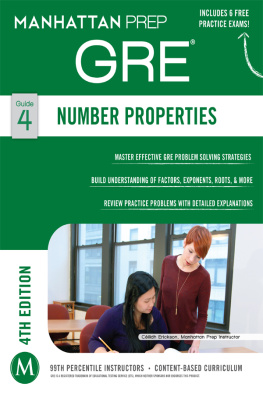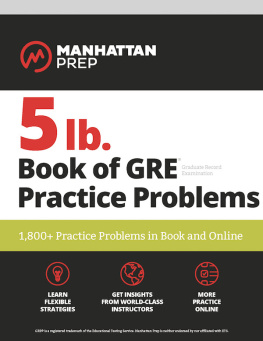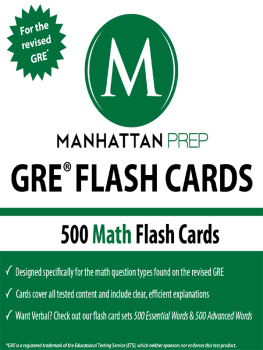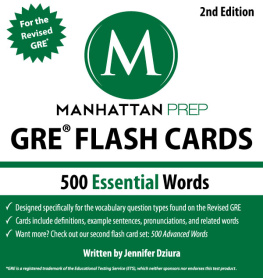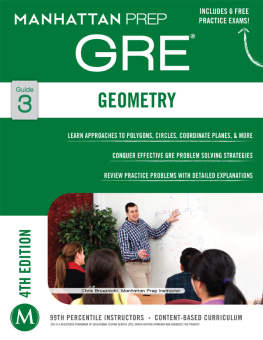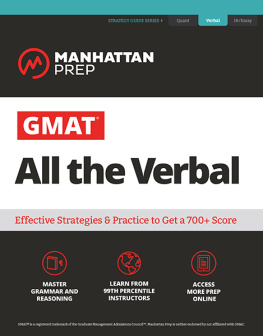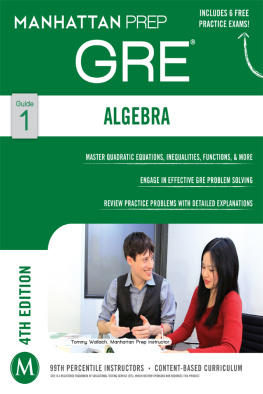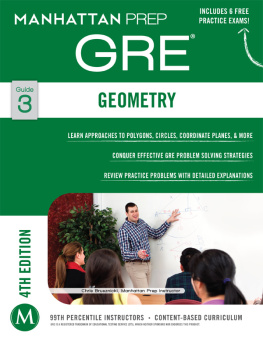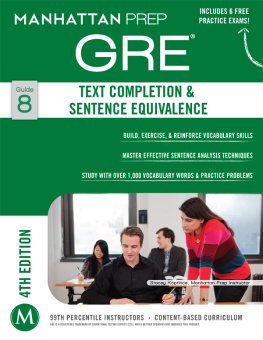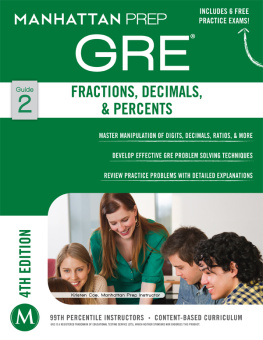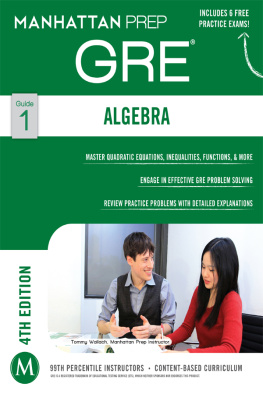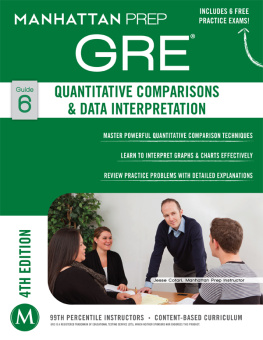Chapter 1
Introduction
We know that you're looking to succeed on the GRE so that you can go to graduate school and do the things you want to do in life.
We also know that you may not have done math since high school, and that you may never have learned words like adumbrate or sangfroid. We know that it's going to take hard work on your part to get a top GRE score, and that's why we've put together the only set of books that will take you from the basics all the way up to the material you need to master for a near-perfect score, or whatever your goal score may be. You've taken the first step. Now it's time to get to work!
How to Use These Materials
Manhattan Prep's GRE materials are comprehensive. But keep in mind that, depending on your score goal, it may not be necessary to get absolutely everything. Grad schools only see your overall Quantitative, Verbal, and Writing scoresthey don't see exactly which strengths and weaknesses went into creating those scores.
You may be enrolled in one of our courses, in which case you already have a syllabus telling you in what order you should approach the books. But if you bought this book online or at a bookstore, feel free to approach the booksand even the chapters within the booksin whatever order works best for you. For the most part, the books, and the chapters within them, are independent; you don't have to master one section before moving on to the next. So if you're having a hard time with something in particular, you can make a note to come back to it later and move on to another section. Similarly, it may not be necessary to solve every single practice problem for every section. As you go through the material, continually assess whether you understand and can apply the principles in each individual section and chapter. The best way to do this is to solve the Check Your Skills and Practice Sets throughout. If you're confident you have a concept or method down, feel free to move on. If you struggle with something, make note of it for further review. Stay active in your learning and stay oriented toward the testit's easy to read something and think you understand it, only to have trouble applying it in the 12 minutes you have to solve a problem.
Study Skills
As you're studying for the GRE, try to integrate your learning into your everyday life. For example, vocabulary is a big part of the GRE, as well as something you just can't cram foryou're going to want to do at least a little bit of vocab every day. So try to learn and internalize a little bit at a time, switching up topics often to help keep things interesting.
Keep in mind that, while many of your study materials are on paper (including Education Testing Service's [ETS's] most recent source of official GRE questions, The Official Guide to the GRE revised General Test, Second Edition), your exam will be administered on a computer. Because this is a computer-based test, you will not be able to underline portions of reading passages, write on diagrams of geometry figures, or otherwise physically mark up problems. So get used to this now. Solve the problems in these books on scratch paper. (Each of our books talks specifically about what to write down for different problem types.)
Again, as you study, stay focused on the test-day experience. As you progress, work on timed drills and sets of questions. Eventually, you should be taking full practice tests (available at www.manhattanprep.com/gre) under actual timed conditions.
The Revised GRE
As of August 1, 2011, the Quantitative and Verbal sections of the GRE underwent a number of changes. The actual body of knowledge being tested is more or less the same as it ever was, but the way that knowledge is tested changed. Here's a brief summary of the changes, followed by a more comprehensive assessment of the new exam.
The current test is a little longer than the old test, lengthened from about 3.5 hours to about 4 hours. When you sign up for the exam at www.ets.org/gre, you will be told to plan to be at the center for 5 hours, since there will be some paperwork to complete when you arrive, and occasionally test-takers are made to wait a bit before being allowed to begin.
Taking a four-hour exam can be quite exhausting, so it's important to practice not only out of these books, but also on full-length computer-based practice exams, such as the six such exams you have gained access to by purchasing this book (see for details).
There are now two scored Math sections and two scored Verbal sections. A new score scale of 130170 is used in place of the old 200800 scale. More on this later.
The Verbal section of the GRE changed dramatically. The Antonyms and Analogies disappeared. The Text Completion and Reading Comprehension remain, expanded and remixed in a few new ways. Vocabulary is still important, but is tested only in the context of complete sentences.
The Quant section of the new GRE still contains the same multiple-choice problems, Quantitative Comparisons, and Data Interpretations (which are really a subset of multiple-choice problems). The revised test also contains two new problem formats, which we will introduce in this section.
On both Verbal and Quant, some of the new question types have more than one correct answer, or otherwise break out of the mold of traditional multiple-choice exams. You might say that computer-based exams are finally taking advantage of the features of computers.
One way that this is true is that the new exam includes a small, on-screen, four-function calculator with a square root button. Many test-takers will rejoice at the advent of this calculator. It is true that the GRE calculator will reduce emphasis on computationbut look out for problems, such as percents questions with tricky wording, that are likely to foil those who rely on the calculator too much. In short, the calculator may make your life a bit easier from time to time, but it's not a game changer. There are zero questions that can be solved entirely with a calculator. You will still need to know the principles contained in the six Quant books (of the eight-book Manhattan Prep GRE series).
Finally, don't worry about whether the new GRE is harder or easier than the old GRE. You are being judged against other test-takers, all of whom are in the same boat. So if the new formats are harder, they are harder for other test-takers as well.
Additionally, graduate schools to which you will be applying have been provided with conversion charts so that applicants with old and new GRE scores can be compared fairly (GRE scores are valid for five years).
Exam Structure
The revised test has six sections. You will get a 10-minute break between the third and fourth sections and a 1-minute break between the others. The Analytical Writing section is always first. The other five sections can be seen in any order and will include:
- Two Verbal Reasoning sections (20 questions each in 30 minutes per section)
- Two Quantitative Reasoning sections (20 questions each in 35 minutes per section)
- Either an unscored section or a research section
An unscored section will look just like a third Verbal or Quantitative Reasoning section, and you will not be told which of them doesn't count. If you get a research section, it will be identified as such, and will be the last section you get.

All the question formats will be looked at in detail later in the chapter.

